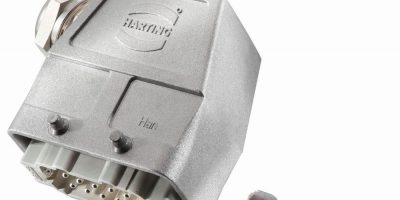High temperature connectors take industry 4.0’s heat
As manufacturers investigate how to best apply industry 4.0 digitalisation processes to existing production plant environments to improve productivity levels and reduce costs, it is becoming necessary to implement a more modular approach to production platforms. This can involve either the application of new modular machines into a production line or retrofitting existing installed equipment to support a more modular and decentralised interconnected control system solution.
In harsh environmental plant conditions, where equipment is sited in areas with high operating temperatures, it has been necessary to hard-wire equipment due to the limitations in the operating performance of a connector. To address this, Harting has released the Han High Temp range of connectors to support applied connectorisation in these conditions. The connector reduces wiring complexity for the installation to be optimised and for maintenance costs reduced.
Typical end-user applications include support for modular production cells within metal production foundries and rolling mills, including integrated electrical heating control feeds to die-cast tools and electric furnaces which may be applied in various high-temperature material processing areas. In addition, they can significantly extend the service maintenance intervals of integrated removable mould tools within modularly designed plastics injection moulding machines for high-temperature materials, resulting in reduced line downtime. They can also be used in tyre manufacturing and chemical processing plant environments.
As bulkhead-side connector seals must not melt or adhere to other integrated component parts over the full operating temperature range, Harting uses a non-stick coated high-temperature-resistant rubber version, which avoids bonding between the hood and housing even if they are left mated for a number of years.
Many of the hood and housing coatings and lacquers available on the market are not suitable for long-term use at high temperatures as they can cause melting which can, in turn, lead to mated parts sticking together. The application of a special surface treatment of the aluminium die-cast hoods and housings, says Harting, allows the elimination of any potentially detrimental additional protective coating finish.
The insulating body and contacts must both withstand the high ambient conditions of the location and the additional heat generated inside the housing when under mated load. Harting has selected high-temperature-resistant copper alloy contacts that maintain constant electrical properties when heated. In addition, high-temperature LCP plastic insulators ensure long service life.
The Han High Temp connectors are able to permanently withstand operating ambient conditions of +200 degree C, provide extended operating lifetimes and ensure reduced line downtime compared to competitor solutions, claims Harting.




